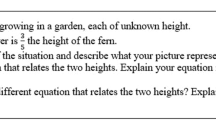Abstract
Although equal sharing problems appear to support the development of fractions as multiplicative structures, very little work has examined how children's informal solutions reflect this possibility. The primary goal of this study was to analyze children's coordination of two quantities (number of people sharing and number of things being shared) in their solutions to equal sharing problems and to see to what extent this coordination was multiplicative. A secondary goal was to document children's solutions for equal sharing problems in which the quantities had a common factor (other than 1). Data consisted of problem-solving interviews with students in 1st, 3rd, 4th, and 5th grades (n=112). We found two major categories of strategies: (a) Parts Quantities strategies and (b) Ratio Quantities strategies. Parts quantities involved children's partitions of continuous units expressed in terms of the number of pieces that would be created. Ratio quantities involved children's creation of associated sets of discrete quantities. Within these strategies, children drew upon a range of relationships among fractions, ratio, multiplication, and division to mentally or physically manipulate quantities of sharers and things to produce exhaustive and equal partitions of the items. Additionally, we observed that problems that included number combinations with common factors elicited a wider range of whole-number knowledge and operations in children's strategies and therefore appeared to support richer interconnections than problems with relatively prime or more basic number combinations.
Similar content being viewed by others
References
Behr, M., Harel, G., Post, T. and Lesh, R.: 1992, ‘Rational number, ratio, and proportion’, in D. Grouws (ed.), Handbook of Research on Mathematics Teaching and Learning, Macmillan, New York, pp. 296–333.
Carpenter, T.P., Ansell, E., Franke, M.L., Fennema, E. and Weisbeck, L.: 1993, ‘Models of problem solving: A study of kindergarten children's problem-solving processes’, Journal for Research in Mathematics Education 24(5), 427–440.
Charles, K. and Nason, R.: 2000, ‘Young children's partitioning strategies’, Educational Studies in Mathematics 43, 191–221.
Courant, R. and Robbins, H.: 1996, What is mathematics? 2nd ed., Oxford, New York.
Dienes, Z.P.: 1967, Fractions: An Operational Approach, Herder and Herder, New York.
Empson, S.B.: 1999, ‘Equal sharing and shared meaning: The development of fraction concepts in a first-grade classroom’, Cognition and Instruction 17(3), 283–342.
Empson, S.B.: 2003, ‘Low-performing students and teaching fractions for understanding: An interactional analysis’, Journal for Research in Mathematics Education 34, 305–343.
Ginsburg, H., Kossan, N., Schwartz, R. and Swanson, D.: 1983, in H. Ginsburg (ed.), The Acquisition of Mathematical Concepts and Processes, Academic, New York, pp. 8–46.
Greeno, J., Collins, A. and Resnick, L. (1996). ‘Cognition and learning’, in D. Berliner and R. Calfee (eds.), Handbook of Educational Psychology, Macmillan, New York, pp. 15–46.
Greer, B.: 1992, ‘Multiplication and division as models of situations’, in D. Grouws (ed.), Handbook of Research on Mathematics Teaching and Learning, Macmillan, New York.
Kieren, T.: 1988, ‘Personal knowledge of rational numbers: Its intuitive and formal development’, in J. Hiebert and M. Behr (eds.), Number Concepts and Operations in the Middle Grades, Lawrence Erlbaum, Hillsdale, NJ, pp. 162–181.
Kieren, T.: 1995, ‘Creating spaces for learning fractions’, in J. Sowder and B. Schappelle (eds.), Providing a Foundation for Teaching Mathematics in the Middle Grades, State University of New York Press, New York, pp. 31–65.
Lamon, S.: 1996, ‘The development of unitizing: Its role in children's partitioning strategies’, Journal for Research in Mathematics Education 271(2), 170–193.
Nunes, T. and Bryant, P.: 1996, Children Doing Mathematics, Blackwell, Cambridge, MA.
Piaget, J., Inhelder, B. and Szeminska, A.: 1960, The Child's Conception of Geometry (E.A. Lunzer, Trans.), Basic, New York.
Pothier, Y. and Sawada, D.: 1983, ‘Partitioning: The emergence of rational number ideas in young children’, Journal for Research in Mathematics Education 14, 307–317.
Saxe, G., Taylor, E., McIntosh, C. and Gearhart, M.: in press, ‘Representing fractions with standard notation: A developmental analysis’, Journal of Research in Mathematics Education.
Schwartz, D.L., Martin, T. and Pfaffman, J.: in press, ‘How mathematics propels the development of physical knowledge’, Journal of Cognition and Development. Manuscript in press.
Schwartz, J.: 1988, ‘Intensive quantity and referent transforming arithmetic operations’, in J. Hiebert and M. Behr (eds.), Number Concepts and Operations in the Middle Grades, Lawrence Erlbaum, Hillsdale, NJ, pp. 53–92.
Steffe, L.P.: 2002, ‘A new hypothesis concerning children's fractional knowledge’, Journal of Mathematical Behavior 2, 267–307.
Steffe, L.P.: 1994, ‘Children's multiplying schemes’, in G. Harel and J. Confrey (eds.), The Development of Multiplicative Reasoning in the Learning of Mathematics, State University of New York Press, Albany, NY, pp. 3–40.
Streefland, L.: 1991, Fractions in Realistic Mathematics Education, Kluwer, Boston.
Streefland, L.: 1993, ‘Fractions: A realistic approach’, in T.P. Carpenter, E. Fennema and T. Romberg (eds.), Rational Numbers: An Integration of Research, Lawrence Erlbaum, Hillsdale, NJ, pp. 289–325.
Thompson, P. and Saldanha, L.: 2003, ‘Fractions and multiplicative reasoning’, in J. Kilpatrick, W.G. Mateo and D. Schifter (eds.), A Research Companion to Principles and Standards for School Mathematics, National Council of Teachers of Mathematics, Reston, VA, pp. 95–113.
Vergnaud, G.: 1988, ‘Multiplicative structures’, in J. Hiebert and M. Behr (eds.), Number Concepts and Operations in the Middle Grades, Lawrence Erlbaum, Hillsdale, NJ, pp. 141–161.
Author information
Authors and Affiliations
Corresponding author
Rights and permissions
About this article
Cite this article
Empson, S.B., Junk, D., Dominguez, H. et al. Fractions as the Coordination of Multiplicatively Related Quantities: A Cross-Sectional Study of Children's Thinking. Educ Stud Math 63, 1–28 (2006). https://doi.org/10.1007/s10649-005-9000-6
Published:
Issue Date:
DOI: https://doi.org/10.1007/s10649-005-9000-6




